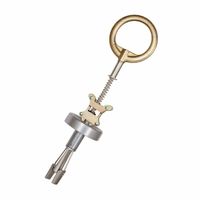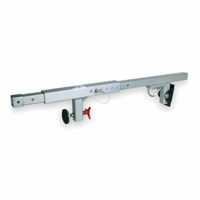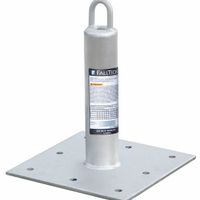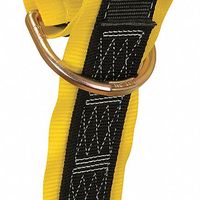Call +(254) 703 030 000 / 751 483 999 / 721 704 777
- Home
- Safety
- Fall Protection
- Anchorage Connectors
.....Read More
Frequently Asked Questions
What are the different types of anchorage connectors and their specific applications?
Anchorage connectors are critical components in fall protection systems, providing secure attachment points for personal fall arrest systems. Here are the different types and their specific applications:
1. **D-Ring Anchors**: These are versatile and can be used in various environments. They are typically installed on steel beams or concrete structures and are suitable for both temporary and permanent applications.
2. **Beam Anchors**: Designed for use on I-beams, these connectors can be adjusted to fit different beam sizes. They are ideal for construction sites where workers need to move along the beam.
3. **Concrete Anchors**: These are used in concrete structures and can be either temporary or permanent. They are often used in construction and maintenance of concrete buildings.
4. **Roof Anchors**: Specifically designed for roofing applications, these anchors can be temporary or permanent. They are used to secure workers on sloped or flat roofs during installation or maintenance.
5. **Cross-Arm Straps**: These are portable and versatile, used to create an anchor point by wrapping around beams or other structures. They are commonly used in construction and maintenance work.
6. **Door/Window Jamb Anchors**: These are used in situations where traditional anchorage points are unavailable, such as in residential construction or maintenance.
7. **Tripod Anchors**: Used in confined space entry, these portable systems provide a secure anchor point for workers entering tanks, manholes, or other confined spaces.
8. **Horizontal Lifeline Systems**: These are used when workers need to move horizontally across a structure. They are common in bridge construction and maintenance.
9. **Vertical Lifeline Systems**: Used for climbing applications, such as ladders or towers, providing continuous fall protection as the worker ascends or descends.
Each type of anchorage connector is designed to meet specific safety requirements and environmental conditions, ensuring the safety and mobility of workers in various industries.
How do you determine the appropriate anchorage connector for a specific structure or material?
To determine the appropriate anchorage connector for a specific structure or material, consider the following factors:
1. **Material Compatibility**: Ensure the anchorage connector is compatible with the material of the structure (e.g., steel, concrete, wood). Different materials require specific types of connectors to ensure secure attachment and prevent damage.
2. **Load Requirements**: Assess the load capacity needed for the application. The anchorage connector must support the maximum expected load, including any dynamic forces, with an appropriate safety factor.
3. **Environmental Conditions**: Consider environmental factors such as temperature, moisture, and chemical exposure. Select connectors made from materials that can withstand these conditions without degrading.
4. **Type of Work**: Identify the type of work being performed (e.g., fall arrest, work positioning, restraint). Different applications may require specific anchorage solutions.
5. **Installation Method**: Evaluate the installation process and ensure it is feasible for the specific structure. Some connectors may require drilling, welding, or other specific installation techniques.
6. **Regulatory Compliance**: Ensure the anchorage connector meets relevant safety standards and regulations (e.g., OSHA, ANSI, EN standards) for the intended use.
7. **Inspection and Maintenance**: Consider the ease of inspection and maintenance. Choose connectors that allow for regular inspection and are durable enough to require minimal maintenance.
8. **Manufacturer Recommendations**: Follow the manufacturer's guidelines and recommendations for the specific anchorage connector, as they provide valuable insights into the appropriate use and limitations.
By carefully evaluating these factors, you can select an anchorage connector that ensures safety, reliability, and compliance with applicable standards for the specific structure or material.
What are the installation guidelines for anchorage connectors on concrete surfaces?
1. **Assessment and Planning**: Evaluate the concrete surface for structural integrity and load-bearing capacity. Ensure the surface is clean, dry, and free from debris or contaminants.
2. **Selection of Anchorage Connectors**: Choose appropriate anchorage connectors based on the load requirements, environmental conditions, and type of concrete. Consider factors like corrosion resistance and compatibility with the concrete.
3. **Drilling Holes**: Use a hammer drill with a carbide-tipped masonry bit to drill holes into the concrete. The diameter and depth of the holes should match the specifications provided by the anchorage connector manufacturer.
4. **Cleaning Holes**: Remove dust and debris from the drilled holes using a brush or compressed air. This ensures proper adhesion and strength of the anchorage.
5. **Installation of Anchors**: Insert the anchorage connectors into the holes. For mechanical anchors, tighten them using a torque wrench to the specified torque value. For adhesive anchors, inject the adhesive into the hole before inserting the anchor, ensuring it is fully embedded.
6. **Curing Time**: Allow adequate curing time for adhesive anchors as per the manufacturer's instructions. This ensures the adhesive sets properly and achieves maximum strength.
7. **Inspection and Testing**: Inspect the installed anchors for proper installation and alignment. Conduct pull-out tests if necessary to verify the load capacity and ensure compliance with safety standards.
8. **Documentation**: Record the installation details, including the type of anchors used, installation date, and any test results. Maintain this documentation for future reference and compliance verification.
9. **Regular Maintenance**: Periodically inspect the anchorage connectors for signs of wear, corrosion, or damage. Perform maintenance or replacement as needed to ensure ongoing safety and performance.
How do you ensure the structural integrity of the component where the anchorage connector is installed?
To ensure the structural integrity of the component where the anchorage connector is installed, follow these steps:
1. **Material Selection**: Choose materials with adequate strength, durability, and corrosion resistance. Ensure compatibility with the anchorage connector and the environment.
2. **Design Verification**: Conduct structural analysis using finite element methods or other engineering tools to verify that the component can withstand expected loads, including dynamic and static forces.
3. **Load Testing**: Perform load tests to simulate real-world conditions and verify that the component can handle the maximum expected loads without failure.
4. **Compliance with Standards**: Ensure the design and installation comply with relevant industry standards and regulations, such as OSHA, ANSI, or ISO, which provide guidelines for safety and performance.
5. **Quality Control**: Implement rigorous quality control measures during manufacturing to ensure components meet design specifications. This includes material testing, dimensional checks, and non-destructive testing.
6. **Installation Procedures**: Follow precise installation procedures to prevent improper installation, which can compromise structural integrity. Use skilled personnel and appropriate tools.
7. **Inspection and Maintenance**: Establish a regular inspection and maintenance schedule to identify and rectify any wear, corrosion, or damage. This includes visual inspections and, if necessary, more detailed assessments like ultrasonic testing.
8. **Documentation and Record Keeping**: Maintain detailed records of design calculations, material certifications, installation procedures, and inspection reports to ensure traceability and accountability.
9. **Risk Assessment**: Conduct a thorough risk assessment to identify potential failure modes and implement mitigation strategies, such as redundancy or safety factors.
10. **Training and Competency**: Ensure personnel involved in design, installation, and maintenance are adequately trained and competent in their roles.
By systematically addressing these areas, the structural integrity of the component where the anchorage connector is installed can be effectively ensured.
What are the safety standards and regulations for installing anchorage connectors?
Safety standards and regulations for installing anchorage connectors are primarily governed by organizations such as the Occupational Safety and Health Administration (OSHA) in the United States and the European Union's EN standards.
1. **OSHA Standards**: OSHA 29 CFR 1926.502 outlines the requirements for fall protection systems, including anchorage connectors. Anchorage points must support at least 5,000 pounds per employee attached or be part of a complete personal fall arrest system maintaining a safety factor of at least two under the supervision of a qualified person.
2. **EN Standards**: In Europe, EN 795 specifies the requirements for anchor devices. These devices must be tested to withstand forces of at least 12 kN for single-user systems. The standard categorizes anchor devices into different types (A to E) based on their design and installation.
3. **Installation Guidelines**: Anchorage connectors should be installed by a competent person following the manufacturer's instructions. They must be placed at a height that minimizes free fall distance and potential swing hazards. The location should be free from sharp edges and other hazards that could compromise the integrity of the system.
4. **Inspection and Maintenance**: Regular inspection is crucial. OSHA requires that fall protection systems, including anchorage connectors, be inspected before each use and periodically by a competent person. Any signs of wear, damage, or corrosion necessitate immediate replacement.
5. **Training**: Workers must be trained in the proper use, installation, and inspection of anchorage connectors. This includes understanding the limitations and proper attachment techniques to ensure safety.
6. **Documentation**: Maintain records of installation, inspections, and training to ensure compliance with safety regulations and facilitate audits.
These standards ensure that anchorage connectors provide reliable fall protection, minimizing the risk of injury or fatality in the workplace.
How do you inspect and maintain anchorage connectors to ensure ongoing safety?
To ensure the ongoing safety of anchorage connectors, follow these steps:
1. **Visual Inspection**: Regularly inspect anchorage connectors for signs of wear, corrosion, deformation, cracks, or any other damage. Pay special attention to welds, bolts, and attachment points.
2. **Check for Corrosion**: Look for rust or other signs of corrosion, especially in outdoor or humid environments. Use anti-corrosion treatments if necessary.
3. **Examine Fasteners**: Ensure all bolts, nuts, and other fasteners are tight and in good condition. Replace any that are worn or damaged.
4. **Assess Load Capacity**: Verify that the anchorage connectors are rated for the loads they are expected to bear. Check for any changes in the load requirements or conditions.
5. **Review Manufacturer Guidelines**: Follow the manufacturer's instructions for maintenance and inspection. This includes adhering to recommended inspection intervals and procedures.
6. **Test Functionality**: Conduct load tests periodically to ensure the anchorage connectors can handle the required loads. Use non-destructive testing methods to avoid damaging the connectors.
7. **Document Inspections**: Keep detailed records of all inspections, maintenance, and repairs. Note the date, findings, and any actions taken.
8. **Training**: Ensure that personnel responsible for inspections are properly trained and understand the importance of identifying potential issues.
9. **Replace When Necessary**: If any component of the anchorage connector is found to be compromised, replace it immediately. Do not attempt to repair unless specified by the manufacturer.
10. **Environmental Considerations**: Consider the environmental conditions where the connectors are used. Extreme temperatures, chemicals, or other factors may necessitate more frequent inspections.
11. **Compliance**: Ensure that all anchorage connectors meet relevant safety standards and regulations.
By following these steps, you can maintain the integrity and safety of anchorage connectors, thereby ensuring the safety of the systems they support.
What are the common mistakes to avoid when installing anchorage connectors?
1. **Incorrect Placement**: Placing anchorage connectors in weak or inappropriate locations can compromise their effectiveness. Ensure they are installed on strong, stable structures capable of supporting the intended loads.
2. **Improper Selection**: Using the wrong type of anchorage connector for the specific application or environment can lead to failure. Select connectors that are suitable for the materials and conditions they will be exposed to.
3. **Ignoring Manufacturer Instructions**: Failing to follow the manufacturer's guidelines for installation can result in improper setup. Always adhere to the specified procedures and recommendations.
4. **Inadequate Inspection**: Not inspecting the anchorage points and connectors before installation can lead to using damaged or unsuitable equipment. Conduct thorough inspections to ensure all components are in good condition.
5. **Overloading**: Exceeding the load capacity of the anchorage connectors can cause them to fail. Be aware of the load limits and ensure they are not surpassed.
6. **Improper Angle of Installation**: Installing connectors at incorrect angles can reduce their strength and effectiveness. Follow guidelines for the correct angle of installation to maintain integrity.
7. **Neglecting Environmental Factors**: Failing to consider environmental conditions such as corrosion, temperature, and moisture can affect the durability and performance of the connectors. Choose materials and designs that can withstand these factors.
8. **Lack of Training**: Untrained personnel installing anchorage connectors may not understand the critical aspects of proper installation. Ensure that only trained and knowledgeable individuals perform the installation.
9. **Failure to Test**: Not testing the anchorage system after installation can leave potential issues undiscovered. Conduct tests to verify that the system is secure and functioning as intended.
10. **Improper Maintenance**: Neglecting regular maintenance and inspections can lead to deterioration and failure over time. Establish a routine maintenance schedule to ensure ongoing safety and performance.








